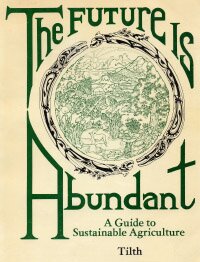
The Future is Abundant
A Guide to Sustainable Agriculture
Tilth Producers of Washington Home | WA Tilth Assoc. | Conference | Directory | Journal | Placement Service | Calendar | Action Alerts
Legislative Update | Bulletin Board | Classifieds | Questions on Agriculture? | Photo Gallery | Links | Contact Us | Join Now | Volunteer

Most cities and suburbs are home to many trees, both native and exotic. Seen from a high vantage point, these trees present the aspect of a mixed forest, predominantly hardwoods, dressed for winter with conifers. In addition to being good green company, trees add to the urban landscape shade from the summer sun, shelter from the winter wind, and a touch of quiet against the city noise.
In recent years, the long-unquestioned urban-concrete-grey assumption has been challenged by the growing practical science of urban tree use and management, called urban forestry. The new urban forestry movement fosters a cooperative spirit, involving everyone in the community in planting and protecting trees.
Isabel Wade is president of Urban Resource Systems, Inc. She is working to bring food and fuel production into cities around the world. Following is an excerpt from a two-part report on urban self-reliance which originally appeared in the September and December, 1981 issues of Development Forum, published by the U.N. Division for Economic and Social Information, Palace of Nations, CH-1200, Geneva 10, Switzerland.
The resilience of any given city to a food/fuel crisis in the 1980s will depend largely upon its capacity to meet at least some of its own basic food and fuel needs. While this idea may seem novel or even preposterous to some, the fact remains that through the first half of this century, most urban areas around the world produced a significant amount of food and other items required by local residents. Production was not limited to the urban fringe but included substantial yields in home gardens and market gardens within the cities themselves. The Parisian "marais" or market gardens of 100 years ago serve as an excellent example of this type of productive urban agroecosystem.
Fortunately, the developing world itself provides some of the most impressive examples of cities adopting more self-sufficient approaches in meeting food and fuel needs. Some of these cities have programmes which are more than half a century old. Each of the examples here is an exciting illustration of the possibilities for greater self-reliance in urban areas in diverse geographical, climatological, and cultural settings.
The cities of Addis Ababa, Ethiopia, and Lae, Papua New Guinea, offer two examples of urban settlements which have become more self-reliant in fuel needs by developing urban forestry programmes. The programme in Addis Ababa dates back to the turn of the century when massive plantations of Eucalyptus globulus were planted through a Government-sponsored programme in an effort to solve the fuelwood shortage of the nation's capital. By 1964, the urban forest of Addis Ababa reportedly had grown to 250 square kilometers (135 kilometers actually covered by trees). The eucalyptus wood is used for a multitude of purposes besides fuelwood ranging from lumber to fence posts.
Lae's urban forestry scheme, begun in 1977, was designed to produce both fuelwood and tree crops and to arrest the erosion of hillsides around the city caused by rampant cutting of trees. An initial 12 sq km site has been planted adjacent to the city, primarily with Leucaena. A smaller area has been planted with both leucaena and various fruit trees. A further aspect of Lae's program which helps to meet the need of the urban poor for fuelwood is a system of firewood distribution centres around the city. Set up by the city council, the centres provide off-cuts from the city's lumber mill free of charge to settlement dwellers.
Growing more food and woodfuel in urban areas requires not only a recognition of the productive potential of small and marginal spaces but also an awareness of how to maximize the food or fuel potential of vegetation that already exists and how to select appropriate vegetation with the interests of greater self-reliance in mind. For example, many trees and shrubs with multiple-use potential are found in urban areas but are not utilized to their fullest capacity. In Manila, Leucaena trees now grace the city's streets for shade and beautification. These trees, however, are also a source of food for humans and livestock, as well as an excellent source of fuelwood.
Street trees and parks also provide an opportunity to produce fruit and nuts for urban residents. In Bangalore, India, for example, approximately 25 percent of the street tree population are fruit trees. A co-ordinated programme of tree crop planting along city street and in parks is one of the most effective ways to produce high yields of valuable food on limited space in urban centres.
Tilth Producers of Washington Home | WA Tilth Assoc. | Conference | Directory | Journal | Placement Service | Calendar | Action Alerts
Legislative Update | Bulletin Board | Classifieds | Questions on Agriculture? | Photo Gallery | Links | Contact Us | Join Now | Volunteer